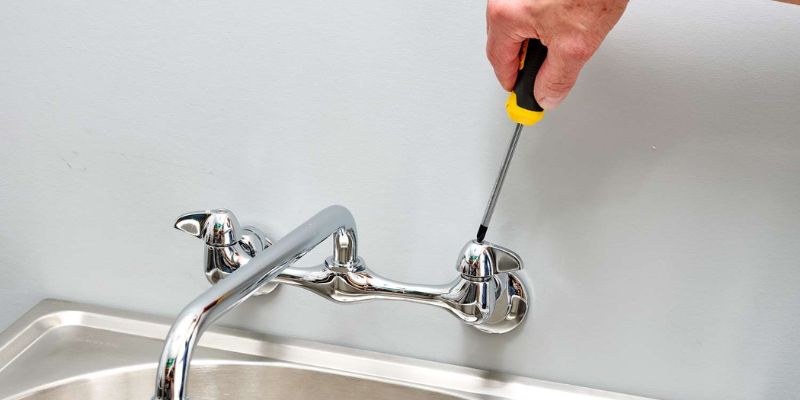A dripping faucet can be a source of frustration and waste. In addition to disrupting your peace, the constant drip also raises your water bill. However, rest assured! With a little guidance and the appropriate tools, anyone can fix a faucet that is leaking. We will walk you through “How Do I Fix a Leaky Faucet?” in detail in this article, allowing you to save money and water.
How Do I Fix a Leaky Faucet?
Although repairing a leaking faucet may appear daunting, it can be made simple and manageable with the right approach. Let’s get into the detailed procedure for repairing a dripping faucet:
Stop providing water:
It is absolutely necessary to shut off the faucet’s water supply before you begin any repairs. Locate the shut-off valves beneath the sink and turn them in the clockwise direction to stop the flow of water. You may need to turn off your home’s main water supply if you can’t locate the shut-off valves.
Gather the necessary tools:
To fix a leaky faucet, you will need a few essential tools. Make sure you have the following items on hand:
- Adjustable wrench
- Screwdriver (flathead and Phillips)
- Pliers
- Replacement parts (such as O-rings, washers, or cartridges)
- Plumbing tape
Determine the type of faucet:
Faucets come in different types, such as compression, cartridge, ball, or ceramic disc. Identifying the type of faucet you have is crucial as it determines the repair method and the replacement parts required. If you’re unsure about your faucet type, consult the manufacturer’s instructions or do some online research.
Inspect the faucet:
Take a close look at the faucet to identify the source of the leak. Is the leak coming from the spout or the handle? Is it a slow drip or a constant stream? Understanding the problem will help you choose the appropriate solution.
Replace the O-rings:
If your faucet is leaking from the handle, the O-rings may be the culprit. To replace them, follow these steps:
- Use a flathead screwdriver to pry off the decorative cap on the handle.
- Unscrew the handle using a screwdriver or an Allen wrench, depending on the faucet type.
- Locate the O-rings inside the handle assembly and remove them.
- Install new O-rings of the same size and shape.
- Reassemble the handle, making sure it is securely attached.
Replace the washers:
Compression faucets often leak from the spout due to worn-out washers. To fix this issue, follow these steps:
- Turn off the water supply to the faucet.
- Remove the handle by unscrewing the screw or nut holding it in place.
- Take out the stem assembly and locate the rubber washers at the bottom.
- Replace the washers with new ones of the same size.
- Reassemble the faucet, ensuring everything is tightened properly.
Replace the cartridge:
Cartridge faucets may require replacing the entire cartridge to fix leaks. Here’s how you can do it:
- Shut off the water supply to the faucet.
- Remove the handle by loosening the screw or nut holding it.
- Take out the old cartridge by pulling it straight out
- Install the new cartridge, aligning it properly.
- Reattach the handle and test the faucet for any leaks.
Clean and lubricate the faucet parts:
Over time, mineral deposits can build up on the faucet parts, causing leaks. Cleaning and lubricating the faucet can help prevent future leaks. Follow these steps:
- Disassemble the faucet by removing the handle, spout, and any other removable parts.
- Soak the parts in a mixture of warm water and vinegar to dissolve mineral deposits.
- Use an old toothbrush or a small brush to scrub away any remaining residue.
- Rinse the parts thoroughly and dry them with a clean cloth.
- Apply a thin layer of plumber’s grease or silicone lubricant to the moving parts before reassembling the faucet.
Check for other potential issues:
If the leak persists after attempting the above solutions, there may be other underlying problems. It could be a cracked pipe, loose fittings, or a faulty valve. In such cases, it is advisable to seek professional help to avoid further damage.
Turn on the water supply:
Once you have successfully fixed the leak, it’s time to turn the water supply back on. Slowly open the shut-off valves beneath the sink or turn on the main water supply to your home. Check the faucet for any leaks and ensure it is functioning properly.
Frequently Asked Questions (FAQs)
Q1: How do I know if my faucet needs repair?
A: If your faucet is dripping or leaking water even when fully closed, it is a clear indication that it needs repair. Additionally, any unusual noises, difficulty in turning the handle, or inconsistent water flow may also suggest the need for repairs.
Q2: Can I fix a leaky faucet without professional help?
A: Yes, fixing a leaky faucet is a DIY task that can be tackled without professional assistance. With the right tools and instructions, you can successfully repair most common faucet leaks.
Q3: How much time does it take to fix a leaky faucet?
A: The time required to fix a leaky faucet depends on the complexity of the problem and your familiarity with the repair process. In general, simple repairs can be completed within an hour or less, while more complex issues may take longer.
Q4: Can I prevent faucet leaks from occurring?
A: Regular maintenance and care can help prevent faucet leaks. Ensure that you clean the faucet regularly, replace worn-out parts promptly, and avoid excessive force when turning the handles. Additionally, using a water pressure regulator can also prevent excessive stress on the faucet.
Q5: Are there any safety precautions I should take while fixing a leaky faucet?
A: When working on a faucet, always remember to turn off the water supply before starting the repairs. This will prevent any accidental water damage or injuries. Additionally, use caution when handling tools and sharp objects to avoid accidents.
Q6: What should I do if I’m unable to fix the leaky faucet on my own?
A: If you’re unable to fix the leaky faucet despite your best efforts, it’s best to seek the help of a professional plumber. They have the expertise and experience to handle complex faucet repairs and ensure a lasting solution.
Conclusion
Fixing a leaky faucet doesn’t have to be a daunting task anymore. With the right knowledge and tools, you can tackle this common household issue with ease. By following the step-by-step instructions provided in this article, you’ll be able to identify the problem, choose the appropriate repair method, and successfully fix a leaky faucet.
Remember to take necessary precautions, gather the required tools, and be patient throughout the process. Say goodbye to the annoying drip and enjoy a properly functioning faucet in no time!

